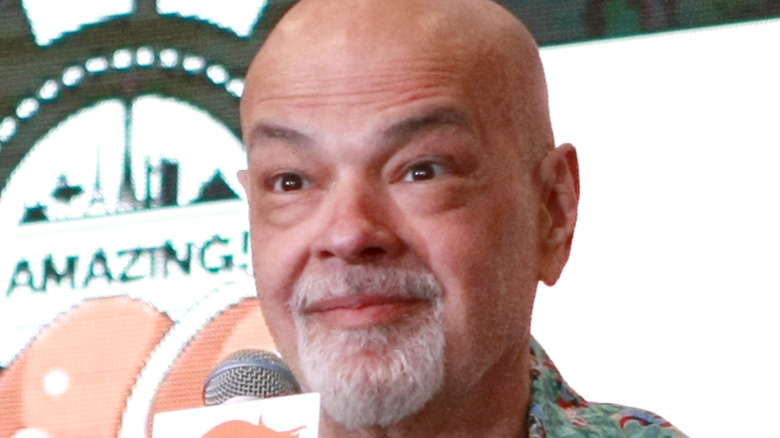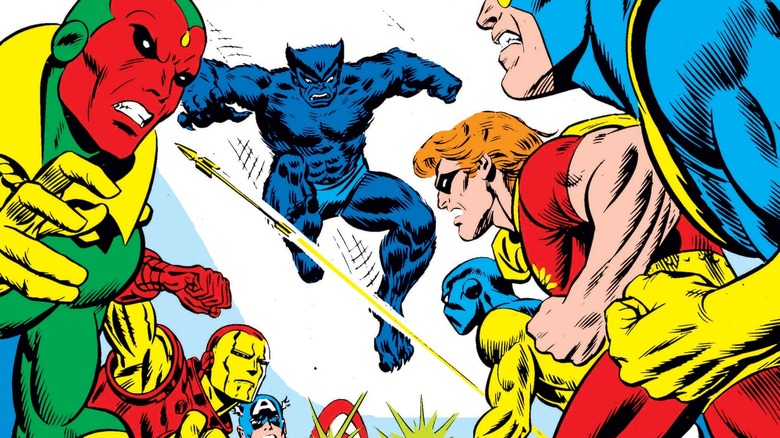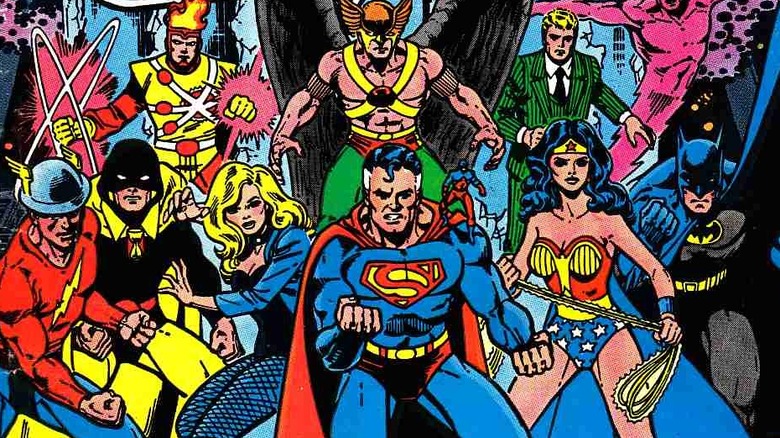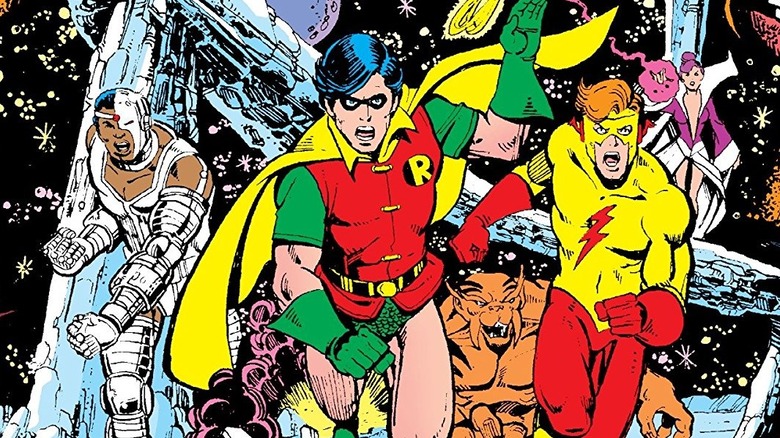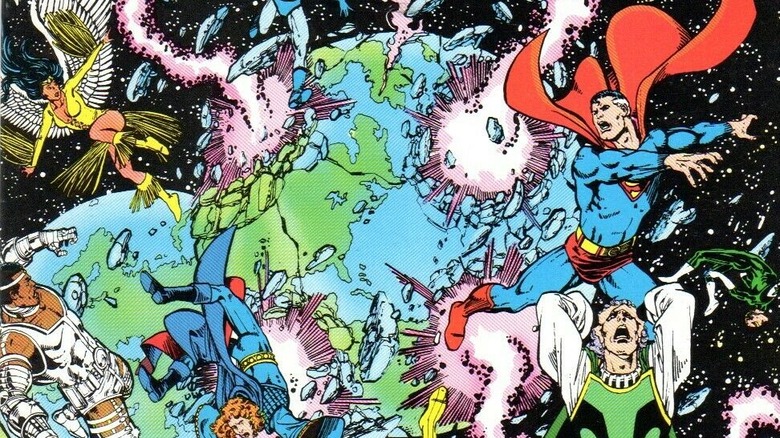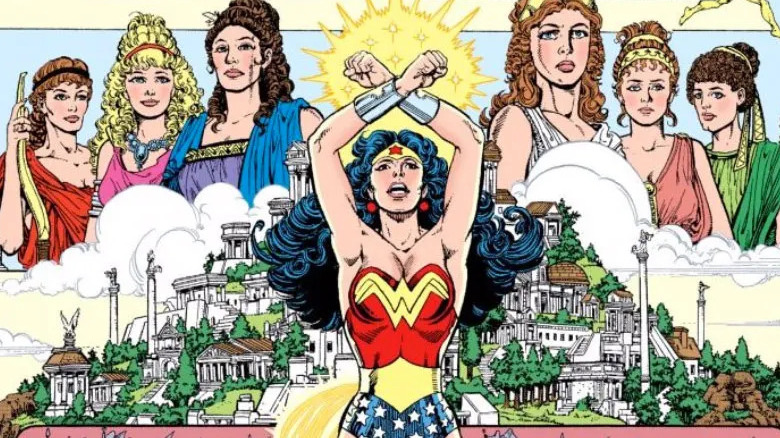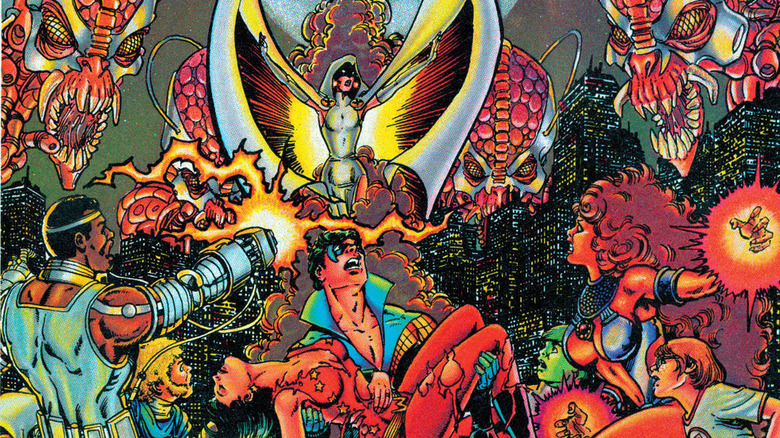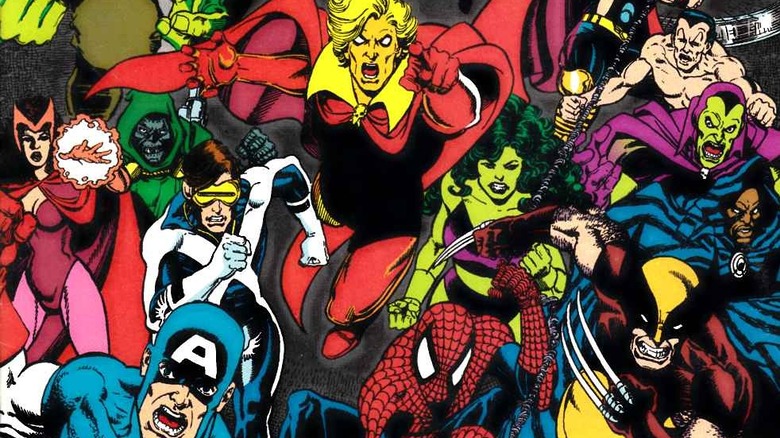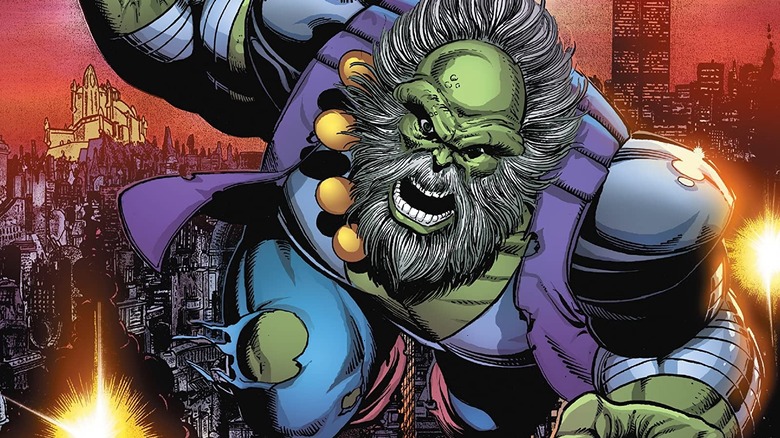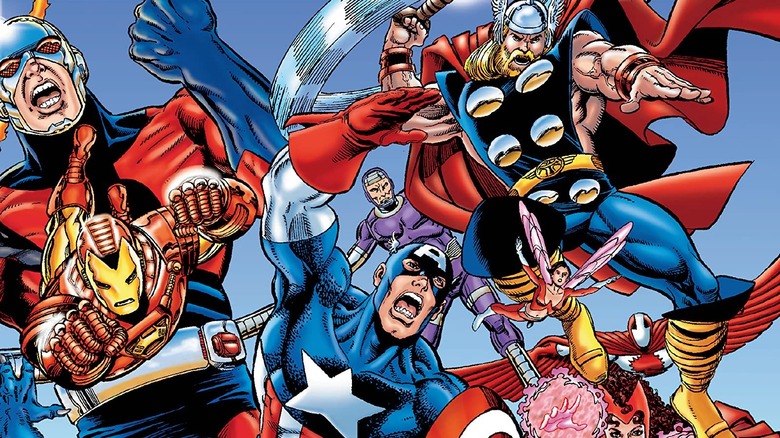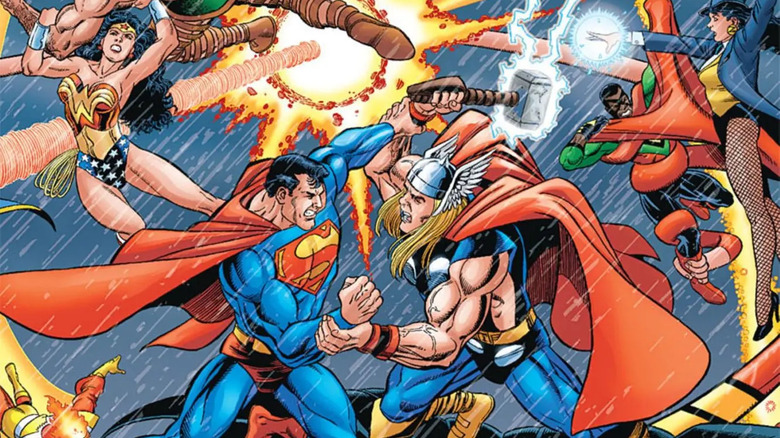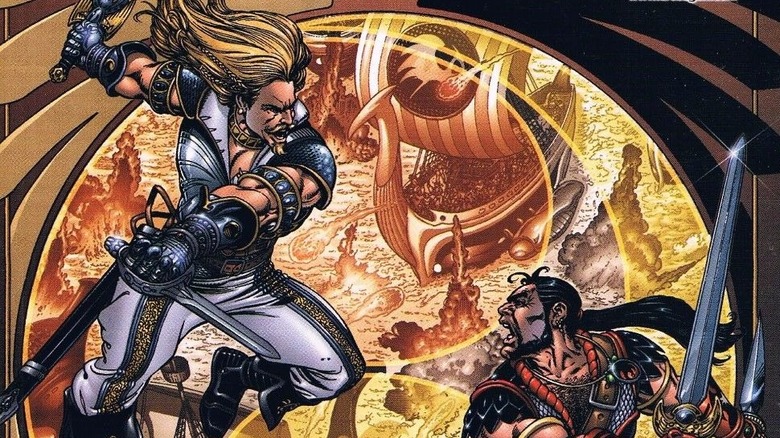George Perez's Most Influential Comics
Comics history is full of great artists from every decade, from Will Eisner to Jack Kirby to Neal Adams. But in the 1980s, one new name came to prominence and would become one of the greatest comic book illustrators of all time: George Perez. The artist had his first works published in the 1970s, and by the mid-80s, he was drawing some of the biggest books on the stand and providing the visuals for some of the most important comics ever produced.
Perez also became well known for doing iconic work for both Marvel and DC at the same time on some of their top books and made a name for himself drawing massive crossovers. His artwork was exquisitely detailed, his layouts dynamic and impressive, and his ability to visualize big ideas and craft scenes with a dozen characters made him perfect for such epic stories.
Perez's influence on the industry may be above description. His stories have inspired movies and TV shows — their images indelibly imprinted on pop culture — and countless artists consider him an influence. Recently retired in 2019, he offered sobering news about his declining health in December of 2021, so we felt the time was right to look back and celebrate some of Perez's most influential comics.
Avengers (1975)
In his book "George Perez Storyteller," the author covers the origins of Perez's career in great detail and spotlights how he had a happy life as a young married man working at a bank but still dreamed of more. "Nothing was going to stop me from being a comic book artist," he said. Fate would lend a hand when artist Rich Buckler hired Perez to be an assistant, helping pull reference material from old comics. But before long, Buckler gave him his first published work: a two-page, fourth-wall-breaking gag story featuring Deathlok in the pages of "Astonishing Tales" #25 in 1974, when he was just 20 years old.
Just a year later, George Perez began his first major work on "The Avengers." Beginning with his first issue, "Avengers" #141, he joined a comic that was already a well-established, popular book. The overarching story of his run involved the Squadron Supreme, a team from an alternate Earth that was patterned after DC Comics' Justice League. Over the course of his time on the title, he showed off his impeccable craftsmanship, strong layout skills, and timeless character design, contributing to the creation of new characters like Hellcat. His work on the big team comic — which features dozens of characters — helped establish him as a skilled illustrator and get the attention of Marvel's rival DC Comics, who also happened to need a new artist for their top superhero team title.
Justice League of America (1980)
Hot off his run on Marvel's "Avengers," DC made the smart decision to bring the burgeoning artist in to draw their own flagship superhero team book, "Justice League of America." His first story for the series involved a crossover with the Justice Society of another Earth, who teamed up with the Justice League to do battle with Darkseid and his armies alongside the New Gods. It was a massive story arc that few could have done justice (pun intended), but Perez's ability to depict incredibly detailed scenes and panels over-stuffed with different characters was the perfect fit for the story. During his two years on the title, Perez got to draw all of the Justice League mainstays, along with heroes like The Atom, Hawkman, Firestorm, Black Canary, Green Arrow, Red Tornado, and many others.
Crucially contributing to such epic tales across multiple Earths set the stage for DC to bring Perez back a few years later when they needed someone to draw their multiverse-spanning continuity-revamping series, "Crisis on Infinite Earths." Of course, having recently worked on both "Justice League" and "Avengers," Perez also became the obvious choice to illustrate an inter-company crossover between the two teams. The artist famously finished penciling a number of pages of before the book before it was unceremoniously called off thanks to Marvel editor-in-chief Jim Shooter's notorious dissatisfaction, and it would be more than two decades before he'd get a chance to revisit the two teams together (but more on that later).
The New Teen Titans (1980)
At the same time that he was working on the end of his "Avengers" run and continuing through his tenure on "Justice League of America," George Perez was brought over to the distinguished competition for the first time to launch a new superhero group book, "The New Teen Titans." Back in those days, it was not at all uncommon for artists to illustrate more than one book a month, and Perez became known for drawing team titles, so DC must have felt that this was a natural fit. A resurrection of a lesser-known teen team from the 1960s, the original version was little more than the teenaged sidekicks of the bigger DC heroes, with a lineup that featured Robin, Wonder Girl, Aqualad, and Kid Flash. The team had seen an attempted revival in the '70s, but DC just couldn't seem to make the group stick. Until George Perez and writer Marv Wolfman revamped the concept for the 1980s, that is.
Overhauling the membership, Wolfman and Perez added the likes of Changeling (later known as Beast Boy), as well as three characters that the pair had created for an issue of "DC Comics Presents": Raven, Cyborg, and Starfire. It can't be overstated how influential this run would be, as this roster became the same group that lead two highly popular animated series and boosted the popularity of characters like Cyborg. During his time on the book, Perez also co-created Deathstroke, one of the most enduring of DC's villains to be introduced during the '80s.
Crisis On Infinite Earths (1985)
With runs on "The Avengers," "The New Teen Titans," and "Justice League of America," George Perez had cemented himself as not just one of the biggest names in comics but as the go-to artist for big team-ups. And there would never be a bigger team-up than DC Comics' 1985 mega event, "Crisis On Infinite Earths." Though Marvel's "Secret Wars" beat it to the stands by a year, this landmark crossover series laid the groundwork for nearly every other major comic book event that has come since. Incorporating the many disparate alternate realities that existed in the DC universe — in this case, numbered Earths — "Crisis on Infinite Earths" was DC's unprecedented attempt at consolidating its nearly 50-year history of multiverse stories into one streamlined continuity. In the years since, fans still use the terms "pre-Crisis" and "post-Crisis" to describe character histories, as the series marked a definitive dividing line between classic continuity and "modern" continuity, and a fundamental shift in the DC Universe.
Perez's artwork played no small part in the success and enduring legacy of the story, with imagery from the series becoming etched in the minds of fans for a lifetime. The art from the series has and continues to influence movies, animated series, and live-action TV shows, planting George Perez's work into the pop-culture consciousness. But more than just being an iconic story or series, "Crisis On Infinite Earths" made Perez one of the industry's top names, giving him his choice of assignments in the wake of its release and even the opportunity to do more than just illustrate comics.
Wonder Woman (1986)
In the aftermath of the events in "Crisis on Infinite Earths," DC's greatest heroes suddenly found themselves with new backstories and conglomerations of different depictions seen over the years melded together to form a single, unified canon. "Superman" received a new comic book series by artist John Byrne that introduced fans to his new history, while Batman's revamp was spearheaded by Frank Miller. "Wonder Woman" wasn't left out, receiving her own relaunched title courtesy of George Perez. But this time, he wouldn't just be drawing the superhero action — he'd be writing it too, and in turn establishing much of the new Wonder Woman mythology that has continued to follow the character in the nearly 40 years since.
This new post-Crisis series delved much deeper into Wonder Woman's origins in her native Themyscira, the island of women warriors, than previous stories had. It retconned much of her older comics and formed an entirely new backstory, taking elements from previous stories and merging them with Perez's new ideas. It was his run on this "Wonder Woman" title that heavily influenced Patty Jenkins' movie version of the character, and Perez's series that has become the basis for nearly everything that has come since, with later retcons maintaining most of what Perez established. It was Perez who turned what might have been little more than DC's female Superman into a unique and special hero, with her own corner of the DC universe all to herself. According to Perez, he may have even saved the character from becoming "a raunchy sex object."
New Titans (1988)
By the late 1980s, George Perez had become a respected and trusted creator, and so when DC needed a fresh creative team to inject new life into the Teen Titans following "Crisis on Infinite Earths," they brought Perez back to the title in 1988. Beginning with issue #50, Perez joined the series again, now as penciller and co-writer on a story titled "Who Killed Wonder Girl?" The title also effectively retconned the origin and backstory of the character in the post-Crisis universe and reestablished the team in the new DC Comics continuity.
By this point in the late 1980s, Perez's art was exceptionally polished, and his star so bright that he was more than just a big name in the industry. After a decade on in his career, Perez was now serving as inspiration for younger creators himself, with Image Comics co-founders Erik Larsen and Rob Liefeld — then both young artists just getting their start in the industry at DC — citing him as an influence. In fact, Larsen had drawn several issues of "The New Teen Titans" in-between Perez's two runs, while Liefeld's own "Youngblood" for Image Comics was heavily inspired by his love of the Teen Titans, illustrating how influential Perez's career already was on the next generation of comic book talent.
The Infinity Gauntlet (1991)
Having already illustrated a run on Marvel's flagship "Avengers" title as well as the mega-crossover event series "Crisis on Infinite Earths" some five years earlier, George Perez was the perfect choice — nay, only choice — to take on Marvel's own epic landmark event series, "The Infinity Gauntlet." In a 2019 interview, Perez noted that he accepted the assignment on the series simply so he could have the opportunity to draw as many classic Marvel characters as the story offered. The story altered the course of a number of characters in the Marvel comics, and of course, the event formed the basis for the culmination of 10 years of MCU films in "Endgame," with imagery from the two-part film story often being directly inspired from Perez's illustrations. Several once-obscure heroes would garner renewed attention thanks to the series and the story that leads up to it — including Adam Warlock and Drax the Destroyer — while turning Thanos into one of Marvel's premiere super villains.
Unfortunately, Perez bowed out of the series halfway through after the third issue citing overwork thanks to his commitment to DC's "War of the Gods," only providing inks on the fourth before leaving entirely. "Silver Surfer" artist Ron Lim ably stepped in to complete the series, and while he did fine work to round out the story, nobody could illustrate the epic story the way Perez could.
Hulk: Future Imperfect (1992)
Though Marvel's 1992 series "The Incredible Hulk: Future Imperfect" was just a two-issue story, it affected the industry more than one might think at first glance. The series saw the teaming up of acclaimed "Incredible Hulk" scribe Peter David with artist George Perez, and together they fashioned a dystopian future tale that saw Bruce Banner's Hulk become a villainous tyrant and the "present-day" Hulk attempting to stop him.
Perez once again showed his skill at elaborate scene-crafting and eye for detail, including one memorable moment where the "modern-day" Hulk is walked through Maestro's lair, which is filled with relics from heroes past. From Silver Surfer's board and Dr. Strange's cloak of levitation to Captain America's shield and Iron Man's armor, it's all there, and it provided fans with endless entertainment as they stopped to look over every item in Maestro's collection.
But more than just a book of easter eggs, it was one of the first high-profile projects to show a bleak future centered on an older, darker version of a major hero. While it wasn't the first to do so, it helped establish the concept as a prestige story, and its style and tone can be felt in similar stories like Mark Millar's "Old Man Logan."
Avengers (1998)
After yet another run on DC's "Teen Titans," this time solely as the series' writer, George Perez was the man chosen to bring the classic Avengers team back to comics. Throughout the 1990s, flashy younger artists had stolen the spotlight from long-time industry stalwarts like Perez, but by the end of the decade, the industry was again shifting. After a controversial and unsuccessful diversion called "Heroes Reborn" that saw Marvel cancel "The Avengers" and relaunch it with a continuity-smashing reboot by trendy Image Comics creator Rob Liefeld, Marvel was ready to relaunch a classic "Avengers" book. Originally asked to write and draw the new series, Perez opted to simply illustrate the book, while Kurt Busiek was chosen as the title's author. Ditching the flashy gimmicks and trendy characters of recent versions, this new volume of "The Avengers" went back to its roots, with a team consisting of its classic roster mainstays: Captain America, Thor, Iron Man, Giant-Man, The Wasp, Scarlet Witch, The Vision, and Hawkeye.
At the center of it all, though, was George Perez. The book was a smash hit, consistently placing in the top ten — something it hadn't done in years. It brought Perez back to the top of the biggest names in the industry, with his involvement in the line-wide relaunch "Heroes Return" even helping to attract talent, as would be revealed in his book "George Perez Storyteller." His run on this new series was some of his best work to date — perhaps ever in his career — and allowed him to spread his wings on a variety of story arcs that included villains like Morgan le Fay, the Squadron Supreme, and robotic tyrant Ultron.
JLA/Avengers (2003)
Marvel and DC had put aside their rivalry a few times to give fans a special treat, but their two titanic teams never met to do battle to decide which was the greatest hero team of all time. They had come close once in the early 1980s, with George Perez himself penciling nearly two dozen pages before the project was abruptly given the kibosh. But in the early 2000s, writer Mark Waid was leading a resurgence of "JLA" over at DC, and Kurt Busiek and George Perez were lighting up the charts with "The Avengers" at Marvel. Both teams were at the top of their game, and with the Perez currently working on "Avengers," they already had the perfect artist, and stars aligned to make the long-awaited clash finally happen.
The four-issue prestige format series landed in 2003 and was one of the most anticipated, high-profile projects of the decade, and it didn't disappoint. Featuring just about every character who had ever been a member of either team — as well as a multitude of each team's biggest villains — the project could be viewed as the culmination of George Perez's entire career. The artist used his experience at both companies to craft one of the best looking and most dynamic adventures ever put to page, and his eye for detail and penchant for cramming panels full of characters was used to great effect. It's one of the most ambitious superhero comic books ever produced, and it not only delivered but also became a shining example of what makes inter-company crossovers so special.
Honorable Mention: Crossgen Comics (2000)
In 1998, a new comic book company emerged that would make major waves in the industry. While it didn't last long, it marked a shift in who gets behind new upstart companies and who joins them, how talent gets recruited, and how they exploit their properties. They were called Crossgen Comics, and owner Mark Alessi wanted to try and save the industry by treating talent better. His idea was simple: Crossgen hired its writers and artists as full-time salaried employees — with healthcare benefits to boot — who would work out of an office building in Tampa, Florida. This would give comic creators unprecedented financial security, as companies like Marvel and DC hired creators freelance, and indie outfits like Image Comics paid creators from the profits, often making it pretty risky business.
When George Perez was announced to join the stable of creators at Crossgen, it was major news. While there was some strong talent already at the company — including some established names — Perez's presence showed that it wasn't just young up-and-comers or journeymen veterans, but superstar talent too. Though his time at Crossgen didn't produce any all-time classics and his output deteriorated due to health issues, his attachment to the company showed the industry that creators across the board weren't just looking to own their work — they wanted to be respected as valued employees too. While Crossgen didn't survive long, its impact in that regard can still be felt, and Perez was a big part of it.
